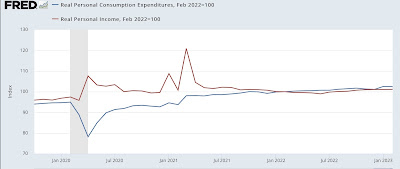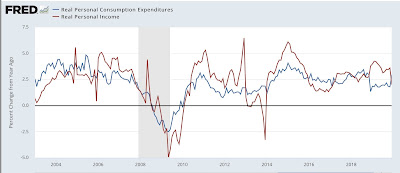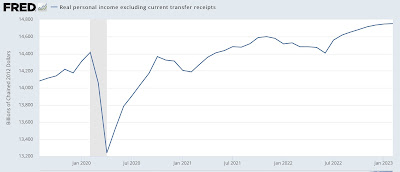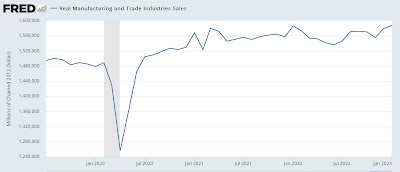Real income in February rises slightly; real spending declines slightly; real total sales in January rose sharply, as expected – by New Deal democrat As I wrote earlier this week, personal income and outlays is one of the two most important data releases at the current time, along with the monthly jobs report. That’s because these are the two sectors of the economy that have most prominently not rolled over, and are keeping us out of recession. This morning’s February release was the proverbial mixed bag. Nominally, personal income rose 0.3% and spending rose 0.2%. But because the deflator also rose 0.3%, in real terms income was unchanged, and spending actually declined -0.1%. Here’s what they both look like since before the pandemic
Topics:
NewDealdemocrat considers the following as important: NewDealdemocrat, US EConomics
This could be interesting, too:
NewDealdemocrat writes JOLTS revisions from Yesterday’s Report
Bill Haskell writes The North American Automobile Industry Waits for Trump and the Gov. to Act
Bill Haskell writes Families Struggle Paying for Child Care While Working
Joel Eissenberg writes Time for Senate Dems to stand up against Trump/Musk
Real income in February rises slightly; real spending declines slightly; real total sales in January rose sharply, as expected
– by New Deal democrat
As I wrote earlier this week, personal income and outlays is one of the two most important data releases at the current time, along with the monthly jobs report. That’s because these are the two sectors of the economy that have most prominently not rolled over, and are keeping us out of recession.
This morning’s February release was the proverbial mixed bag.
Nominally, personal income rose 0.3% and spending rose 0.2%. But because the deflator also rose 0.3%, in real terms income was unchanged, and spending actually declined -0.1%. Here’s what they both look like since before the pandemic (normed to 100 as of 12 months ago):

YoY real spending rose 2.5%, and real income rose 1.1%. For comparison, here is the YoY% change over the past 20 years up until the pandemic:

A 2.5% increase in real spending is about par for the course for the past 20 years, while the 1.1% increase in real income is lower than almost all times outside of recessions (and for 2013, after Social Security withholding was increased by 1%):
Meanwhile, the personal savings rate rose 0.1% to 4.6%, which is a nice rebound from last June’s all-time low:

But on the other hand, a rise in the savings rate is typically seen just in advance of recessions, as consumers grow more cautious.
The personal income and spending release is also important because it feeds directly into 2 of the 4 coincident indicators most relied upon by the NBER to determine if the economy is in expansion or recession.
The first of the 2 is real personal income less government transfer receipts. This rose less than 0.1%, rounding to 0. While this has risen 0.9% in the past 6 months, it has only risen 0.25% for the last three:

In other words, this important coincident indicator could very well be peaking – and indeed, have peaked – in February.
The second of the 2 is real manufacturing and trade sales, which relies in part on the PCE deflator. This increased a sharp 0.5% for January, which sounds good:

But the big January increase was telegraphed by the huge 2.7% January gain in real retail sales (which make up about 1/3rd of the number) that we’ve already known about for the past month and a half.
Because this economic series lags so much, you may recall that several weeks ago I premiered two systems to estimate it on a more timely basis. At that time I wrote:
“For January 2023 [using CPI rather than the PCE deflator] , the estimate is an increase of 0.8%. … Because “real” manufacturing and trade sales for December were only 0.4% lower than their all-time record in January 2022, the estimate forecasts that when the official result is reported on March 31, more likely than not it will set a new record.”
The second, more timely system is to average industrial production and real retail sales. Using that estimate, I wrote:
“This method is not so accurate as the 2nd estimate I discussed several days ago, but does give us the main thrust. Like the 2nd estimate, for January it forecasts a sharp increase (+1.5% vs. the +0.8% of the 2nd estimate), followed by a -0.4% decrease in February. Like the 2nd estimate, it indicates a new record high for January.”
As shown above, setting a new record for January is exactly what happened, with the early estimate’s +1.5% being not nearly so good as the later estimate’s +0.8%. I’ll be able to update the February estimate in a couple of weeks.
So to summarize: real personal income and spending were slightly positive to slightly negative, with real income and the savings rate both being consistent with a near recession. Similarly, real personal income less transfer receipts has been decelerating significantly, and may even have peaked in February. Finally, real manufacturing and trade sales rose sharply in January on the back of retail sales, but are likely to decline in February; indeed January may also have marked their peak.
Good news and bad news on personal income and spending, Angry Bear, New Deal democrat.
